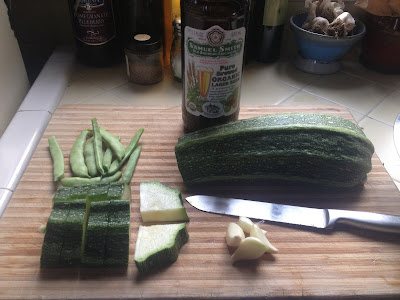Let's go back in time to November 2013. I actually have a backlog of recipes to post, but this will be the mother of all posts that I could post (maybe).
Thanksgiving is a favorite holiday for cooking for us. We love to prepare a giant feast of food that will last us for multiple days and provide us with multiple variations of the meal during those days. It's usually just us for that holiday and we make sure to do it up right. Often people ask, well what do you eat for the Thanksgiving holiday? This question is asked often, especially when the meal for many people is often centered around turkeys or hams or other such items that people consume. Well, I gotta tell ya, that we are never lacking in the department of delicious foods as you will rightly see during this post.
To begin:
Day before the actual holiday, I often prepare as much as I can so that it will allow me to simply put things together and then bake or cook them when the time is right. This year, I began the day before by making the soup, the seitan, the cornbread for the stuffing, and preparing the dessert. When cooking on a small, but powerful propane stove like our old school Wedgewood, you have to prepare and plan ahead and think about your space. I have 4 stovetop burners that are close together and a not so big oven with one rack. Hence the need to prepare some things in advance.
The menu was to be as follows:
butternut squash and sunchoke soup
green pea casserole
jarrahdale pumpkin stuffed with cornbread stuffing
mashed potatoes
mushroom gravy
cranberry sauce
seitan
sauerkraut homemade
garden salad
apple crumble with coconut ice cream and small glasses of homemade Nocino
Day before:
The butternut and sunchoke soup:
butternut peeled and chopped in big chunks
tromboncino unpeeled and chopped
sunchokes chopped
onion diced
garlic whole bulb
lemongrass blades
pineapple sage leaves and flowers
olive oil
salt
water
Begin by chopping and peeling your butternut and tromboncino squashes. Tromboncino squash doesn't necessarily have to be peeled. Roast them in the oven with your bulb of garlic for at least 45 minutes.
Once the squashes are roasted and softened, you can add them to your soup pot with the rest of the ingredients and begin to cook them in your soup pot. I like to brown my veggies a little bit with olive oil before I add the water and salt and herbs. Once these ingredients are softened a little bit, probably about 15 minutes then you can pour all or some of the soup into a blender (we use our vitamix) and blend as you like it. Sometimes I blend just half of the soup for a chunkier soup. This soup was blended fully for a very creamy texture. Soup can be cooled and then put in the fridge until ready to be warmed for the next day.
2 c vital wheat gluten
1 c flour (any kind - I used a mixture of buckwheat, coconut, and corn flours)
handful of oats
2 Tbsp couscous
salt about 1 tsp
herbs/spices as desired
an even amount of liquid as your dry ingredients so about 3 c water
Mix all dry ingredients together. Add liquid and mix by hand making sure to incorporate all dry ingredients with the wet ingredients into a sticky mound. Add a little water or dry ingredients as necessary until you have a cohesive ball of gluten. Wrap in cheese cloth and tie with cooking twine. Put into a large soup pot in a cooking broth made of any vegetable or fruit ingredients, salt and water. Simmer for at least 45 minutes. Allow to cool and then this can be refrigerated for up to a week in it's own broth.
cooking broth can be anything:
water to cover seitan
apples chopped
chile peppers
paprika peppers
tomatoes
garlic unpeeled ok
onions
squash peelings
herbs - rosemary, marjoram
salt less than 1 Tbsp
When ready to cook for the meal, slice off medallions of seitan and fry with a little olive oil in a skillet. Add a little bit of the cooking broth to keep seitan moist.
Unfortunately I didn't pay much attention to the amounts of each ingredient for this cornbread. It was perfect for stuffing as it was a little dense and cakey. Some day I'll have to do another trial run to make an official recipe. Until then I'll write up the ingredients list and you can experiment on your own.
corn flour
white flour
coconut flour (probably about 2 c of flour total)
baking powder (probably about 1 tsp)
salt (about 1 tsp)
lemon juice or mild vinegar (about 1 Tbsp)
water (maybe about 1 c)
Mix all dry ingredients thoroughly. Add liquid ingredients and mix to right consistency somewhere between thick batter and liquidy cake batter. Pour into a cast iron skillet and bake for 30-45 minutes or until center is done. Allow to cool then slice so that it will be dry for using in stuffing.
The apple crumble dessert:
the crumble:
handful of nuts (I used walnuts and pecans)
coconut flour (about 1 c)
coconut sugar (about a half c)
baking powder (less than 1 tsp)
spices (cinnamon, clove)
salt (less than 1 tsp)
earthbalance (4-5 Tbsp)
1-2 Tbsp water
Put all dry ingredients into a blender and pulse until chopped finely. Add chunks of earthbalance to the dry ingredients and chop in roughly with a little bit of water to make the crumble. Put this crumble into the base of a small baking dish and save some for the top.
The apple filling:
2 apples cored and chopped
coconut sugar (about half c)
salt (sprinkle)
cinnamon
lemon juice from 1 lemon
lemon zest from the lemon
left over crumble ingredients (just a little)
Core and chop apples. Add rest of ingredients and mix thoroughly. Add the apple filling on top of the crumble bottom and then add rest of crumble to the top. Can be refrigerated until following day when read to bake.
The day of:
The day of Thanksgiving was a day full of preparation. There was much to chop and dice and blend and cook and prepare. This day was for putting the meal together starting midday.
The green pea casserole:
snap peas (enough to fill casserole dish - mine were frozen, but from the farm)
potatoes chopped
kohlrabi greens removed from bulb and diced stems and all
thyme
summer savory
garlic
coconut milk
salt
Place peas and some chopped potatoes into casserole dish.
In a blender blend up some of the green peas, kohlrabi greens, more potato, herbs, coconut milk, and some salt
Pour into casserole dish and then make your crispy onion topping.
The topping of this casserole dish is very important. Crispy baked onions are essential. I make my own by slicing small onions, mixing in a bowl with some coconut flour and salt and then baking in the oven at 400degF for 20-30minutes with some coconut oil.
multiplier onions peeled and sliced into rounds
coconut flour
salt
coconut oil
Baked all together for 40 minutes at 400degF it comes out like this.
The jarrahdale pumpkin stuffed with cornbread stuffing:
One jarrahdale pumpkin (really this can be any pumpkin or squash - but how cool is this pumpkin!)
one batch of day old cornbread
apple cored and chopped
onion diced
baby carrots tops removed, but left whole
herbs chopped (parsley, rosemary, thyme, and summer savory, sage left whole)
radicchio leaves chopped
olive oil
salt
Place cut up pieces of day old cornbread into bowl. Chop up all herbs, veg, fruits except carrots and sage. Add to cornbread. Add some carrots and then mix all ingredients thoroughly with some olive oil and salt.
Bake pumpkin partially so that it is easier to cut out the top. Stuff pumpkin with cornbread ingredients. Add baby carrots and whole sage branch to top of stuffed pumpkin. Leftover cornbread ingredients were put into base of casserole dish and then pumpkin put on top. Bake in oven for 1 hour or more or until pumpkin seems soft and stuffing ingredients are steaming inside.
The mashed potatoes:
potatoes
chives
olive oil
salt
water
Chop potatoes roughly and boil in plenty of water with olive oil and salt. Boil until soft. Mash with chopped chives and add more olive oil and salt as needed. Add a little potato cooking water as needed for smoother mashed potatoes. Put into a casserole dish for keeping warm until ready to eat.
The mushroom gravy:
mushrooms (I used portobello and king trumpet)
onion
garlic
rosemary sprigs stems removed
coconut flour
salt
water
Chop up all ingredients. Put a little olive oil into pot and turn heat to medium. Add a little coconut flour and make a roux by browning the flour a little before adding the rest of the ingredients. Stir fry the ingredients until browned and then add enough water to make a gravy to the desired consistency.
The cranberry sauce:
Cranberries (1 bag - obviously not from the farm)
spices (cinnamon, allspice, clove)
lemon juice from 1 lemon
lemon zest from lemon
a little bit of coconut sugar
In a skillet turn to medium heat and add cranberries. They will begin to pop and sizzle as they release their juices. Add rest of the ingredients and stir until the cranberries make a sauce.
The sauerkraut:
The sauerkraut was made during the summer and was jarred up after a couple of months of fermenting in the big crock. The sauerkraut used was from one very large golden acre cabbage that was sliced thinly, punched down into the crock and then salt added after each layer. This was then covered with sliced carrots and herbs along with whole onions and small cabbages. All of this was made from veggies harvested from the farm.
The garden salad:
lettuce greens
radicchio head
last of the summer tomatoes
lemon juice
olive oil
Salad assembled as any salad would. Ingredients chopped and placed into a bowl with a drizzle of olive oil and lemon juice.
And here we have it. A delicious thanks for giving - so much good food from the farm meal. Paired with Simtra india pale ale beer and we had a feast.
After the meal, and later in the evening it was time to prepare the dessert for baking. Paired with homemade coconut ice cream and some of our 2011 vintage homemade Nocino, it was the perfect way to spend some time preparing some of our garlic for planting the next morning on the farm.
The dessert again:
coconut ice cream:
3 cans coconut milk
1 c sugar
ice cream maker
Add ingredients to ice cream maker and follow directions to have delicious coconut milk ice cream.
Bake dessert in a 400degF oven for 30 minutes. Scoop hot apple crumble into bowls and top with homemade coconut ice cream. Sip homemade Nocino vintage 2011 with your dessert. Enjoy a nice roaring fire and peel some garlic.
Enjoy!




















































